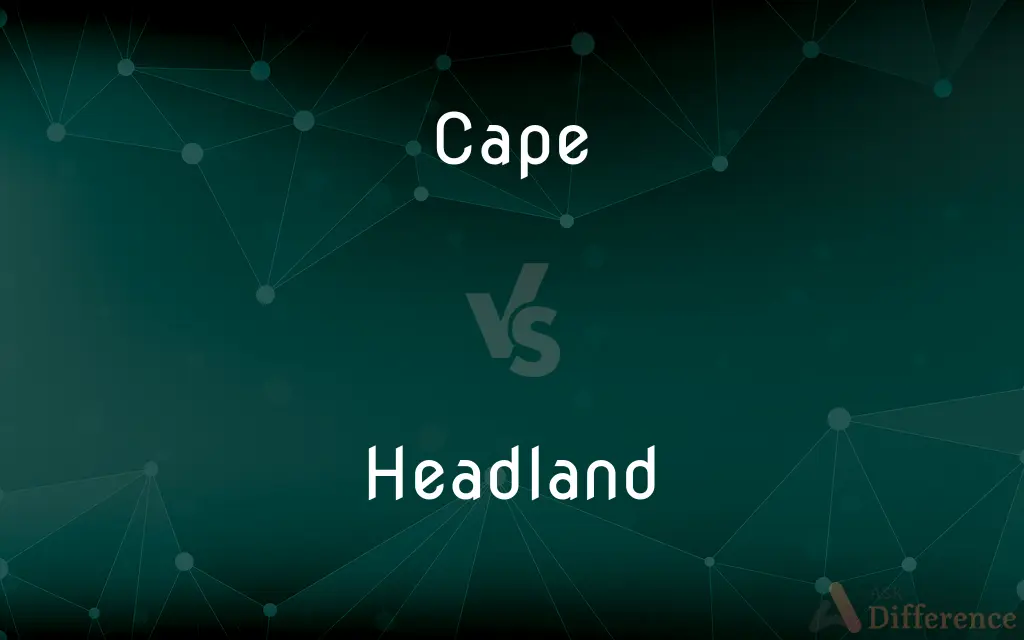Cape vs. Headland — What's the Difference?
Edited by Tayyaba Rehman — By Fiza Rafique — Updated on April 26, 2024
A cape is a prominent point of land that juts into a sea or ocean, usually marked by a significant change in coastline direction; a headland is a narrow piece of land that projects from a coastline into the sea, often characterized by high, steep cliffs.

Difference Between Cape and Headland
Table of Contents
ADVERTISEMENT
Key Differences
Capes and headlands both extend into bodies of water, but capes are generally larger and more pronounced in altering the direction of a coastline. In contrast, headlands are typically characterized by their rugged cliffs and elevated terrain, providing dramatic natural scenery.
A cape, such as Cape Cod, often serves as a significant landmark for navigation and can influence local climates and ocean currents due to its protrusion into the water. Whereas a headland, such as the White Cliffs of Dover, is noted for its geological and ecological significance, often formed by resistant rock that withstands erosion.
The shape and form of a cape can vary widely; some are sandy and gently sloping, others rocky and rugged, depending on the geological and hydrological conditions. On the other hand, headlands are almost always associated with high cliffs and hard rock formations, which contribute to their prominent appearance against the sea.
Human activity on capes can include settlements, ports, and tourism, leveraging the extensive coastlines and strategic locations. Meanwhile, headlands, due to their steep and often inaccessible cliffs, are less likely to be developed, sometimes preserved as natural or heritage sites.
In terms of ecosystem, capes may support a diverse range of habitats due to their varied terrain and the mixing of ocean currents, which can bring rich nutrients to the surrounding waters. Headlands, with their exposure to severe weather and waves, often host specialized plant and animal communities adapted to harsh conditions.
ADVERTISEMENT
Comparison Chart
Definition
A point of land that extends into a sea or ocean
A narrow piece of land projecting into the sea, often with cliffs
Geological Features
Varied, can be sandy or rocky
Typically high, steep cliffs with rocky shores
Size and Shape
Larger, significant alteration of coastline
Narrower, more defined by elevation than breadth
Common Uses
Navigation landmarks, ports, tourism
Natural reserves, sightseeing, limited development
Ecological Impact
Influences local climates and currents
Hosts specialized ecosystems due to harsh conditions
Compare with Definitions
Cape
Often serves as a maritime landmark.
Ships use Cape of Good Hope to navigate around the southern tip of Africa.
Headland
Supports unique ecological systems adapted to extreme conditions.
Some headlands provide critical habitats for seabird colonies.
Cape
Can influence weather patterns and ocean currents.
The Cape Verde Peninsula affects weather across the tropical Atlantic.
Headland
Less suitable for extensive development due to their terrain.
Few headlands are heavily developed; many are preserved for their natural beauty.
Cape
A site of human activity and habitation.
Many capes are popular locations for vacation homes and tourist attractions.
Headland
Characterized by steep cliffs and resistant rock formations.
The rugged cliffs of headlands are often subjects of dramatic photographs.
Cape
A prominent point of land that extends into a sea or ocean.
Cape Horn, known for its challenging sailing conditions, juts into the Southern Ocean.
Headland
A high, narrow piece of land extending into a body of water, usually the sea.
The headlands along the Pacific Coast offer stunning views of the ocean.
Cape
Features varied geography, from sandy beaches to rocky outcrops.
Cape Cod features a mix of broad beaches and marshy inlets.
Headland
Often preserved as part of natural parks or heritage sites.
Many headlands are integral parts of coastal conservation efforts.
Cape
A cape is a sleeveless outer garment which drapes the wearer's back, arms, and chest, and connects at the neck.
Headland
A headland, also known as a head, is a coastal landform, a point of land usually high and often with a sheer drop, that extends into a body of water. It is a type of promontory.
Cape
A sleeveless cloak, typically a short one
He was wearing a flowing cape
Headland
A point of land, usually high and with a sheer drop, extending out into a body of water; a promontory.
Cape
The pelt from the head and neck of an animal, for preparation as a hunting trophy
The hair on a cape for the taxidermist can spoil in warm weather
Headland
The unplowed land at the end of a plowed furrow.
Cape
A headland or promontory
We could see the island from the cape
Headland
Coastal land that juts into the sea.
Cape
(in bullfighting) taunt (the bull) by flourishing a cape
The film shows a man expertly caping a charging bull
Headland
The unplowed boundary of a field.
Cape
Skin the head and neck of (an animal) to prepare a hunting trophy.
Headland
A cape; a promontory; a point of land projecting into the sea or other expanse of water.
Cape
A sleeveless outer garment fastened at the throat and worn hanging over the shoulders.
Headland
A ridge or strip of unplowed at the ends of furrows, or near a fence.
Cape
A brightly colored cloth used in maneuvering the bull in a bullfight; a capote or muleta.
Headland
A natural elevation (especially a rocky one that juts out into the sea)
Cape
A point or head of land projecting into a body of water.
Cape
To maneuver (the bull) by means of a cape in a bullfight.
Cape
(geography) A piece or point of land, extending beyond the adjacent coast into a sea or lake; a promontory; a headland.
Cape
A sleeveless garment or part of a garment, hanging from the neck over the back, arms, and shoulders.
Cape
(slang) A superhero.
Cape
To incite or attract (a bull) to charge a certain direction, by waving a cape.
Cape
(nautical) To head or point; to keep a course.
The ship capes southwest by south.
Cape
To skin an animal, particularly a deer.
Cape
To defend or praise, especially that which is unworthy.
Cape
(obsolete) To look for, search after.
Cape
To gaze or stare.
The captain just caped mindlessly into the distance as his ship was hit by volley after volley.
Cape
A piece or point of land, extending beyond the adjacent coast into the sea or a lake; a promontory; a headland.
Cape
A sleeveless garment or part of a garment, hanging from the neck over the back, arms, and shoulders, but not reaching below the hips. See Cloak.
Cape
To head or point; to keep a course; as, the ship capes southwest by south.
Cape
To gape.
Cape
A strip of land projecting into a body of water
Cape
A sleeveless garment like a cloak but shorter
Common Curiosities
Are headlands always made of rocky cliffs?
While most headlands feature rocky cliffs due to their resistance to erosion, the specific geological composition can vary.
What distinguishes a cape from a headland?
A cape generally affects the direction of the coastline more significantly and may have a wider variety of geographical features, while a headland is characterized by its elevation and steep cliffs.
Do capes affect local weather conditions?
Yes, capes can influence local weather and climate by interacting with maritime currents and wind patterns.
What are some examples of capes around the world?
Examples include Cape Horn, Cape Canaveral, and Cape of Good Hope.
How do human activities differ between capes and headlands?
Capes often host more diverse human activities, including settlements and tourism, while headlands tend to be less developed and preserved for their natural landscapes.
What is the importance of conserving headlands?
Conserving headlands protects their ecological and scenic value, especially as many are home to endangered species and offer erosion control.
Can both capes and headlands serve as navigational landmarks?
Yes, both are used as navigational landmarks, but capes are more likely to be noted on maritime charts due to their impact on ocean currents and shipping routes.
Why are capes significant in maritime history?
Capes have been crucial in maritime navigation as reference points for sailors and in determining shipping routes.
Are there cultural significances associated with capes and headlands?
Both can have cultural significance, often featured in local folklore and as historical landmarks.
What role do headlands play in ecology?
Headlands often host unique plants and animals adapted to the tough conditions of high winds and salt spray.
Share Your Discovery

Previous Comparison
Debate vs. Discuss
Next Comparison
Spittoon vs. CuspidorAuthor Spotlight
Written by
Fiza RafiqueFiza Rafique is a skilled content writer at AskDifference.com, where she meticulously refines and enhances written pieces. Drawing from her vast editorial expertise, Fiza ensures clarity, accuracy, and precision in every article. Passionate about language, she continually seeks to elevate the quality of content for readers worldwide.
Edited by
Tayyaba RehmanTayyaba Rehman is a distinguished writer, currently serving as a primary contributor to askdifference.com. As a researcher in semantics and etymology, Tayyaba's passion for the complexity of languages and their distinctions has found a perfect home on the platform. Tayyaba delves into the intricacies of language, distinguishing between commonly confused words and phrases, thereby providing clarity for readers worldwide.














































